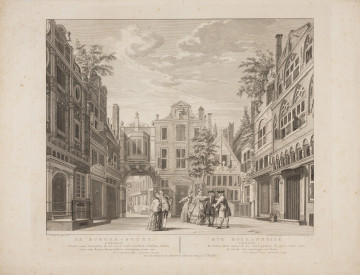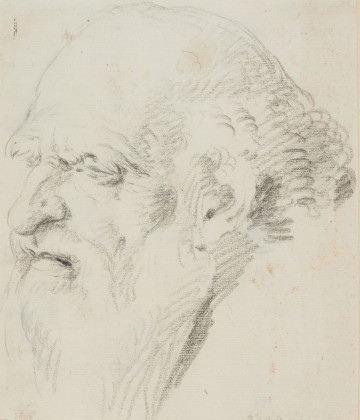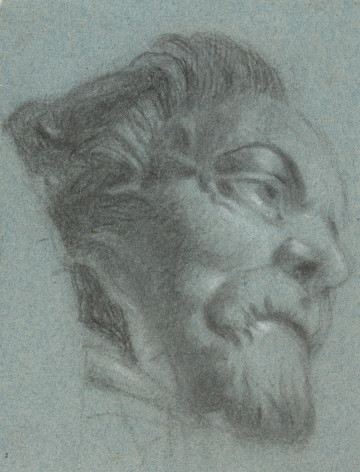
Die Burger-Buurt Adriaan (Rue Hollandoise Adrien) | Amsterdam street (Dutch street Adriaan)
1775
National Museum in Szczecin
Part of the collection: Drawings by Giambattista, Giandomenico and Lorenzo Tiepolo
Giambattista Tiepolo's composition depicts mythological characters - the river nymph Daphne and her father, Peneus. Daphne is about to turn into a laurel tree, and branches are growing out of her fingers. Peneus is leaning against a cracked overturned jug from which water is pouring out, giving rise to the Penejos river, of which he is a deity. Giambattista did not adhere strictly to the myth, which says that Daphne, fleeing from Apollo in love with her, took refuge with her mother. He showed her sheltering with her father. The scene allowed the artist to show the contrast between the young female body and the male body of the older man, which he achieved thanks to the precise use of chiaroscuro.The sketch is a preparatory drawing for the oil painting Apollo and Daphne painted by Tiepolo in 1755-1756, which is now possessed by the National Gallery of Art in Washington. It was drawn with a red crayon, the so-called sanguine, used for drawings and sketches since the Renaissance. It was made on thick blue Venetian paper.The drawing belongs to a group of 36 works by the Tiepolo family, the most extensive collection of drawings by this distinguished and famous 18th-century Venetian artistic family in Poland. The complicated fate of the works was established by Georg Knox, an English researcher on the Tiepolo family's works. After Giandomenico Tiepolo's death, Giambattista's son, the drawings became the property of his disciple Johann Dominic Bossi, a miniaturist and draughtsman, Munich painter at the Bavarian court, active also at courts in Sweden, Russia and Austria. The painter's daughter, Maria Theresa Karolina, wife of Carl Christian Friedrich Beyerlen, secretary to the Duchy of Württemberg, inherited the drawings. The couple lived in Stuttgart, and after their death, the drawings were auctioned off at H.G. Gutekunst's local antiquarian bookshop in 1882. They were bought by a Szczecin lawyer, Johann Theodor Müller, who, motivated by a patriotic impulse, donated them to the collection of the Cabinet of Graphic Arts of the City Museum (Muzeum Miejskie) in Szczecin before 1907, in the period when the Museum was being established. After World War II, the drawings were taken to the Soviet Union. In 1956, they returned to Poland as part of the revindication process, initially as a deposit at the National Museum (Muzeum Narodowe) in Warsaw, and then in two batches, in 1973 and 1984, they were brought back to Szczecin and placed in the Cabinet of Graphic Arts of the National Museum.
Ewa Gwiazdowska
Author / creator
Dimensions
cały obiekt: height: 393 mm, width: 296 mm
Object type
drawing
Creation time / dating
Creation / finding place
Identification number
Location / status

1775
National Museum in Szczecin

około 1751
National Museum in Szczecin

około 1751
National Museum in Szczecin
DISCOVER this TOPIC
Museum of King Jan III's Palace at Wilanów
DISCOVER this PATH
Educational path